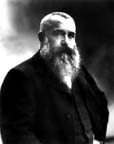The most lyrical of
the impressionist painters, Claude Oscar Monet {moh-nay', klohd}, b.
Nov. 14, 1840, d. Dec. 5, 1926, was also the most committed to
recording transient effects of light and atmosphere.  This
aim led Monet and his colleagues to develop the techniques of
impressionism. Monet advised his fellow painters to concentrate on
the play of light and color of the objects that they had before them.
The goal was to capture temporary phenomena, and this was pursued in
a systematic manner, according to the laws of optics and
complementary color relationships; yet the result was often a sheer
celebration of painting itself, an expression of Monet's delight in
the colors, textures, and shapes of the landscape.
This
aim led Monet and his colleagues to develop the techniques of
impressionism. Monet advised his fellow painters to concentrate on
the play of light and color of the objects that they had before them.
The goal was to capture temporary phenomena, and this was pursued in
a systematic manner, according to the laws of optics and
complementary color relationships; yet the result was often a sheer
celebration of painting itself, an expression of Monet's delight in
the colors, textures, and shapes of the landscape.
During his youth
Monet was struck by the constantly changing appearance of sea and sky
on the north coast of France, near his native city of Le Havre.
There, he became friendly with Eugene Boudin, a painter of coastal
scenes, who encouraged him to become a painter. In 1859, Monet moved
to Paris and attended the Academie Suisse, where he met Camille
Pissarro.  After
a break for military service (1860-62) and a brief return to Le
Havre, he returned to Paris to enroll in the studio of Charles
Gleyre, where he met Pierre Auguste Renoir, Frederic Bazille, and
Alfred Sisley. By 1865 he had embarked on a program of outdoor
painting of marine and forest subjects, townscapes, and figures in
landscape settings.
After
a break for military service (1860-62) and a brief return to Le
Havre, he returned to Paris to enroll in the studio of Charles
Gleyre, where he met Pierre Auguste Renoir, Frederic Bazille, and
Alfred Sisley. By 1865 he had embarked on a program of outdoor
painting of marine and forest subjects, townscapes, and figures in
landscape settings.
In the summer of
1869, Monet worked alongside Renoir and began to emerge as the
leading figure in the creation of the techniques of outdoor
impressionism. He consolidated this role in 1872-75, especially
favoring river subjects with light-dappled water, and garden scenes
in which vigorous brushstrokes and patches of bright color break into
the contours of objects, dissolving their forms in the play of light.
 In 1876-77 he embarked on the plan
of painting a single subject from various viewpoints, choosing for
this purpose the Gare Saint-Lazare, a Parisian railway station (one
of these canvases is in the Fogg Art Museum, Cambridge, Mass.).
In 1876-77 he embarked on the plan
of painting a single subject from various viewpoints, choosing for
this purpose the Gare Saint-Lazare, a Parisian railway station (one
of these canvases is in the Fogg Art Museum, Cambridge, Mass.).
Until the 1880s,
Monet endured extreme poverty. During this decade, however, his works
began to sell at higher prices, allowing him to live and paint as he
wished. In the early 1890s, he again took up the idea of producing a
series of views of the same subject which he intended to be shown as
a group. His subjects included haystacks, poplars, the facade of
Rouen Cathedral as it altered from dawn to dusk, the Seine at
Giverny, and views of the Thames and the Houses of Parliament. But
Monet's key subject after 1890 was the lily pond he had built at his
home in Giverny. His various versions of it culminated in several
groups of large, decorative paintings of water lilies, called
Nympheas. These now hang in the Museum of Modern Art, New York City,
and in the Musee de l'Orangerie, Paris. These paintings show the
vitality and complexity of Monet's brushwork at its height. Sky,
water, and vegetation are transformed into swirling, vibrant masses
of color.
Mark Roskill
Source: The Grolier Multimedia Encyclopedia, Release #9.01, ©1997
Bibliography: Robert Gordon, Monet (1989); John House, Monet (1986); Claire Joyce,
Claude Monet: Life at Giverny (1985); John Rewald and Frances Weitzenhoffer, eds., Aspects
of Monet (1984); Denis Rouart and Leon Degand, Monet, trans. by W. Stephenson (1958);
William Seitz, Claude Monet (1960; repr. 1984); P.H. Tucker, Claude Monet: Life and Art (1995);
Ann Waldron, Claude Monet (1991); Daniel Wildenstein, Monet's Years at Giverny (1978) and
Monet: The Complete Paintings, 1899 to 1926 (1988).
Images: "Monet: photo portrait"
Copyrights Notice and Disclaimer: Images of artists' works displayed throughout this site have
been obtained from numerous sources, including digital libraries at educational institutions,
educational software, and Mark Harden's Artchive.
Credit is attributed when known. Some works are considered to be in the public domain, based on current
U.S. and international copyright acts. For more information on copyright laws, please refer to the
Artists Rights Society and Benedict O'Mahoney's
The Copyright Web Site. [See also:
DiscoverFrance.net Copyrights.]
